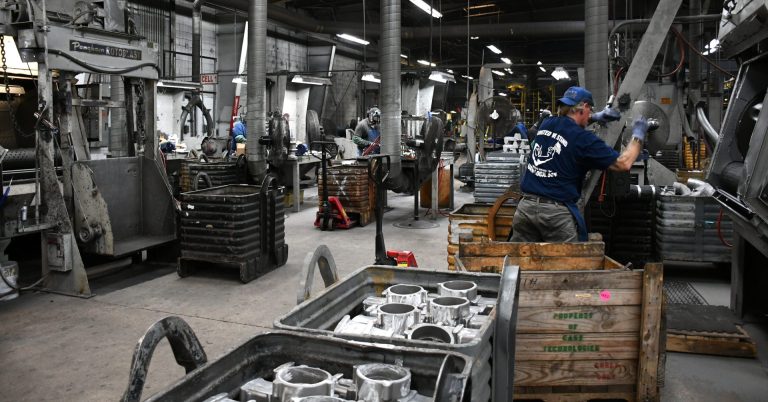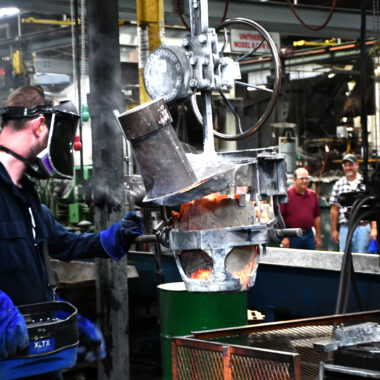Boost Your Production Line: Aluminum Casting Approaches That Deliver Outcomes
Wiki Article
Checking Out the Various Approaches of Light Weight Aluminum Casting: A Comprehensive Guide
Light weight aluminum casting stands as a fundamental procedure in the development of various items we come across daily, from elaborate auto elements to household components. Understanding the varied techniques made use of in aluminum spreading is important for manufacturers looking for accuracy and effectiveness in their manufacturing processes - aluminum casting. As we start this exploration of the numerous techniques entailed in aluminum casting, we reveal a world where technology and tradition assemble to form the products that form our modern world
Sand Spreading Method
Using among the earliest and most commonly utilized approaches in aluminum spreading, the sand spreading method includes developing molds from a mix of sand and a binder product. This technique is highly flexible, cost-efficient, and suitable for creating a vast array of dimensions and forms, making it a preferred choice in various markets.
Aluminum, heated to its melting factor, is then put into the mold and mildew, filling the dental caries. After cooling down and solidifying, the sand mold and mildew is broken away, exposing the aluminum spreading. This method enables the production of complicated geometries and is well-suited for both reduced and high volume manufacturing runs.
Financial Investment Casting Strategy
Having discovered the sand casting approach, a refined technique to aluminum casting is the financial investment casting method, which offers unique benefits in terms of precision and surface area finish. Investment spreading, also understood as lost-wax spreading, is a procedure that involves producing a wax pattern that is covered with a ceramic shell. When the covering is dried out and hardened, it is heated up to get rid of the wax, leaving behind a hollow ceramic mold. Molten light weight aluminum is after that put into the tooth cavity, loading the mold and mildew to create the preferred component.Among the major advantages of investment casting is its ability to produce complex shapes with high precision and elaborate details. The process permits thin wall surfaces, sharp sides, and great surface area coatings that call for marginal post-processing. In addition, financial investment spreading is recognized for its superb dimensional precision and limited resistances, making it a favored technique for creating parts that need tight specifications. Overall, the investment spreading strategy is a efficient and flexible method for manufacturing high-grade aluminum components.
Permanent Mold And Mildew Refine

One of the key advantages of the Long-term Mold Refine is its capability to produce components with a finer grain structure, resulting in boosted mechanical buildings. Furthermore, the reusable nature of the steel mold enables the production of a large number of get rid of consistent top quality. This method is commonly utilized in the automobile, aerospace, and aquatic industries for making elements such as engine pistons, wheels, and architectural parts. By leveraging the Irreversible Mold Refine, producers can attain affordable manufacturing of aluminum get rid of outstanding dimensional precision and surface finish.
Pass Away Casting Method
In contrast to the Irreversible Mold And Mildew Process, the Die Casting Approach for light weight aluminum spreading includes making use of a recyclable steel mold to create elaborate components with high dimensional accuracy. This method is commonly made use of in numerous industries due to its capability to effectively manufacture complicated forms with slim wall surfaces and excellent surface finishes.Die casting normally starts with the prep work of the steel mold and mildew, which is after that splashed with a lubricant to facilitate the removal of the solidified aluminum. The mold is closed, and molten aluminum is injected under high pressure into the cavity. Once the aluminum cools and solidifies, the mold and mildew opens up, disclosing the completed component.
One of the essential advantages of die casting is its high production price, making it a cost-effective service for massive manufacturing. Additionally, parts generated via die spreading display exceptional strength and resilience compared to those made through various other casting techniques. This approach is particularly ideal for applications calling for complex designs, tight resistances, and high repeatability.
Centrifugal Casting Method
Just how can the Centrifugal Spreading Technique enhance the performance and top quality of aluminum casting procedures? Centrifugal casting is a method that makes use of centrifugal force to distribute liquified metal right into a mold cavity. This strategy uses several benefits over standard casting approaches.One key advantage is the exceptional quality of the spreadings produced. The centrifugal pressure helps to remove porosity by pushing any gas or pollutants towards the facility of the casting, leading to a denser and more consistent end product (aluminum casting). Additionally, the rotational movement of the mold and mildew makes certain an extra even circulation of the molten steel, resulting in boosted mechanical navigate to this site homes and reduced flaws
The method enables for the casting of elaborate forms and thin-walled components with convenience, expanding the design possibilities for manufacturers. In conclusion, the Centrifugal Casting Method stands out as a reputable method for improving both the effectiveness and high quality of aluminum spreading processes.

Final Thought
In conclusion, the different methods of aluminum spreading offer one-of-a-kind advantages and features for different applications. Sand casting uses convenience and cost-effectiveness, investment casting permits detailed layouts, permanent mold process guarantees high-grade finishes, die casting supplies high production rates, and centrifugal spreading generates high-strength components. Comprehending the distinctions between these methods can assist suppliers choose the most appropriate strategy for their specific casting requirements.Having actually discovered the sand casting method, a refined technique to light weight aluminum spreading is the financial investment casting technique, which provides unique benefits in terms of accuracy and surface area coating. Financial investment spreading, additionally known as lost-wax casting, is a process that involves creating a wax pattern that is coated with a ceramic shell.How can the Centrifugal Casting Method enhance the efficiency and quality of aluminum casting processes? In conclusion, the Centrifugal Casting Method stands out as a dependable technique for enhancing both the efficiency and quality of aluminum spreading procedures.
Sand spreading uses adaptability wikipedia reference and cost-effectiveness, financial investment casting allows for intricate designs, irreversible mold and mildew procedure guarantees premium surfaces, die view it now casting provides high manufacturing prices, and centrifugal casting produces high-strength parts.
Report this wiki page